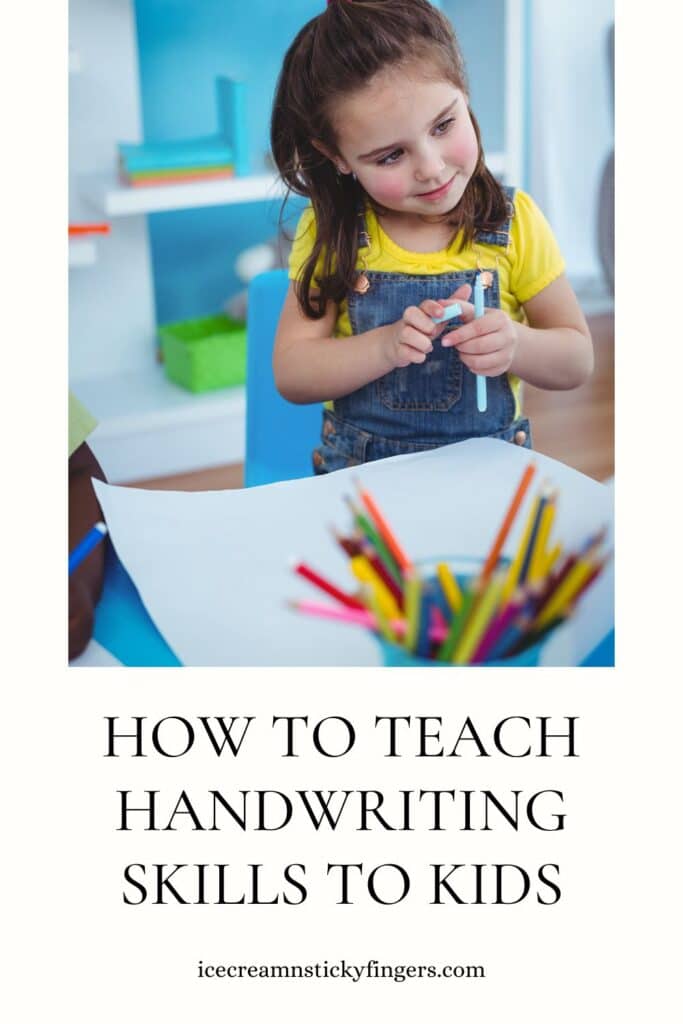Are you looking for ways on how to teach handwriting skills to kids? Handwriting is a skill that everyone must learn. It is a complex skill that requires proper techniques, grip strength, and fine motor skills. Kids will begin learning how to write in kindergarten and it is an important part of their early education. They will continue to build their handwriting skills as they progress throughout the year and beyond. Here are some tips to help you teach handwriting skill to kids effectively:

Start with the Basics
Begin with the fundamentals. Teach children how to write their name, the alphabet, and numbers. Make sure they can recognize and say each letter and number.
Use Appropriate Materials
Provide the right tools, like pencils with a comfortable grip, ruled paper, and erasers. Consider using paper with raised or colored lines to help guide their writing.
Proper Posture and Grip
Teach children how to sit with good posture and hold the writing instrument correctly. They should grip the pencil with their thumb and the first two fingers, and the pencil should rest on their middle finger for stability.
Fine Motor Skills
Activities that develop fine motor skills are essential. These can include coloring, using scissors, and playing with clay or playdough. These activities strengthen the muscles needed for handwriting.
Practice Tracing
Have kids practice tracing letters and numbers. Tracing can help them get a feel for the shapes and movements needed for writing.

Use Dotted or Dashed Letters
Provide worksheets with dotted or dashed letters and numbers (free printable) that kids can trace. These help children understand the correct formation of each character.
Use Multi-Sensory Techniques
Engage different senses in learning to write. For example, you can use sand or shaving cream trays for children to practice writing letters with their fingers. This adds a tactile element to their learning experience.
Integrate Technology
Incorporate educational apps and online resources that focus on handwriting skills. There are many interactive games and programs designed to help children improve their handwriting in a fun and engaging way.
Break It Down
Teach kids to write letters and numbers stroke by stroke. For example, ‘A’ can be broken down into an ‘O’ with a tail. Breaking characters into simpler components makes it easier to learn.
Reinforce Proper Letter Formation
Emphasize starting each letter at the top and encourage a consistent direction for forming letters and numbers.
Letter Formation Rhymes
Some children benefit from using rhymes to remember how to write certain letters. For example, “Big line down, little line across” for the letter ‘T’.
Practice, Practice, Practice
Encourage regular practice, but keep it fun and engaging. Use a mix of handwriting worksheets, games, and creative activities to maintain their interest.
Take Breaks
Handwriting can be tiring, especially for young children who are still developing their fine motor skills. Allow them to take breaks during writing sessions to rest their hands and recharge.
Offer Positive Feedback
Encourage your child and praise their efforts. Positive reinforcement can boost their confidence and motivation.

Set Realistic Expectations
Recognize that each child develops their handwriting skills at their own pace. Don’t rush the process, and be patient.
Model Writing
Let children watch you write, and narrate what you’re doing. They often learn by imitation.
Consistency is Key
Make handwriting practice a consistent part of their daily routine, but keep sessions short and enjoyable.
Be Patient and Persistent
Learning to write takes time and practice. Be patient with children as they develop their handwriting skills, and continue to provide support and guidance along the way.
Seek Professional Help If Needed
If you notice persistent difficulties or signs of dysgraphia, a learning disability that affects writing, consider seeking professional help from an occupational therapist or educational specialist.
Remember that handwriting is a skill that develops over time. Be patient and provide plenty of encouragement and support as your child learns to write. It’s also important to make sure that learning to write remains an enjoyable and creative experience for them. Knowing how to teach handwriting skills to kids is important as they will use writing their entire life. Again, be patient if they don’t get it right away. They will eventually learn.








This is super helpful for my daughter. Her child is five and needs help with her writing.
What fabulous ideas! I should have done some of these with my kids.
These tips for teaching handwriting skills to kids are fantastic! Starting with the basics, using appropriate materials, and incorporating fun activities like tracing and multi-sensory techniques are all great strategies. The emphasis on posture, fine motor skills, and consistency is spot-on. Thanks for sharing such a comprehensive guide to help kids develop their handwriting!
I think it’s great to help teach kids handwriting. These are all extremely helpful ideas for that too.
These are some great tips; my youngest daughter is already being taught handwriting skills and she’s getting better each day. I love how you mentioned allowing kids to take a break, I so agree you don’t want to overwhelm them or tire their little wrist out.
Reinforcing letter formation and offering positive feedback are such great reminders to keep learning fun and encouraging.
These are amazing ways to help your child to learn to write. It is so important to encourage them in a fun way. Thanks for sharing
This is a good skill to know. Teens today can’t even sign their own names! At least they should know how to form the letters for that… 🙂
Those are some great points to keep in mind and always practicing goes a long way!
These are such great tips for teaching handwriting! I remember it was so difficult to help my kids, and I think these would have come in handy.
It is nice to work on writing with kids. In the age of technology, I think kids don’t write nearly as much as they should.